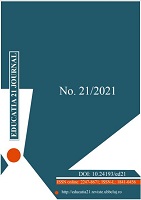How can we illustrate the usefulness of the differential calculus course taught in a technical university
How can we illustrate the usefulness of the differential calculus course taught in a technical university
Author(s): Ștefania Constantinescu, Rodica-Mihaela Dăneț, Marian-Valentin PopescuSubject(s): Higher Education , Pedagogy
Published by: Universitatea Babeş-Bolyai
Keywords: Differential calculus; Lagrange theorem; study of the variation of functions; mathematical modelling; secondorder linear nonhomogeneous differential equation with constant coefficients;Cauchy problem;
Summary/Abstract: Working in a challenging academic environment as mathematics professors for the Technical University of Civil Engineering Bucharest, we thought to find a teaching strategy that, in addition to the required standard, but also has the standard of attractiveness and accessibility. Why? This is due to the fact that our students have a very nonhomogeneous level of knowledge and logical-mathematical skills. That's how we came up with the idea of organizing each lesson in our courses in a gradual way, and completing them with an informal part. On the other hand, we set out to collaborate with professors working in the departments of other natural sciences or in engineering departments, enriching the mathematics courses with technical applications. This has led to write several didactic works, which also include such applications. Proving the usefulness of this courses, our new work offers two such technical applications for the mathematical analysis course, taught in the first semester and dedicated to the differential calculus of functions having one or several variables. More precisely, we present in a gradual way, two applications solved by using the mathematical modelling: a problem belonging to electricity and then, the cruising speed problem. The gradual presentation begins, for each of these problems, with the necessary notions (organized in the form of two dictionaries, for Math and for Physics, respectively), continues with the statement of the problem, with the solution methodology, and finally, with the solution itself. Our presentation will provide students with a model of logical (mathematical) approach, useful to them in the courses of other natural sciences and of engineering disciplines that they will study later. In addition, it will prove them why mathematics is a fundamental discipline for the engineering education.
Journal: Educatia 21
- Issue Year: 2021
- Issue No: 21
- Page Range: 107-122
- Page Count: 16
- Language: English

